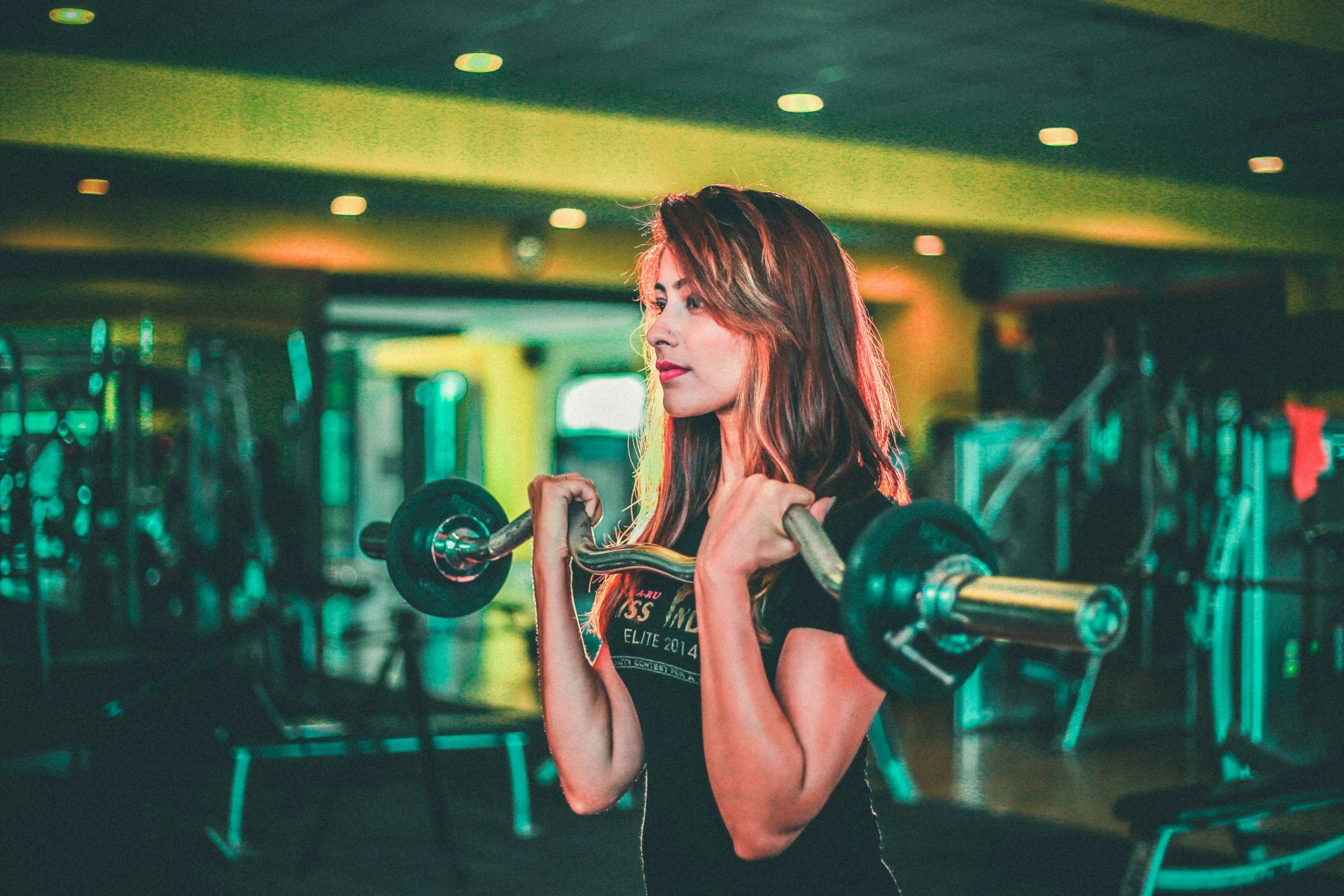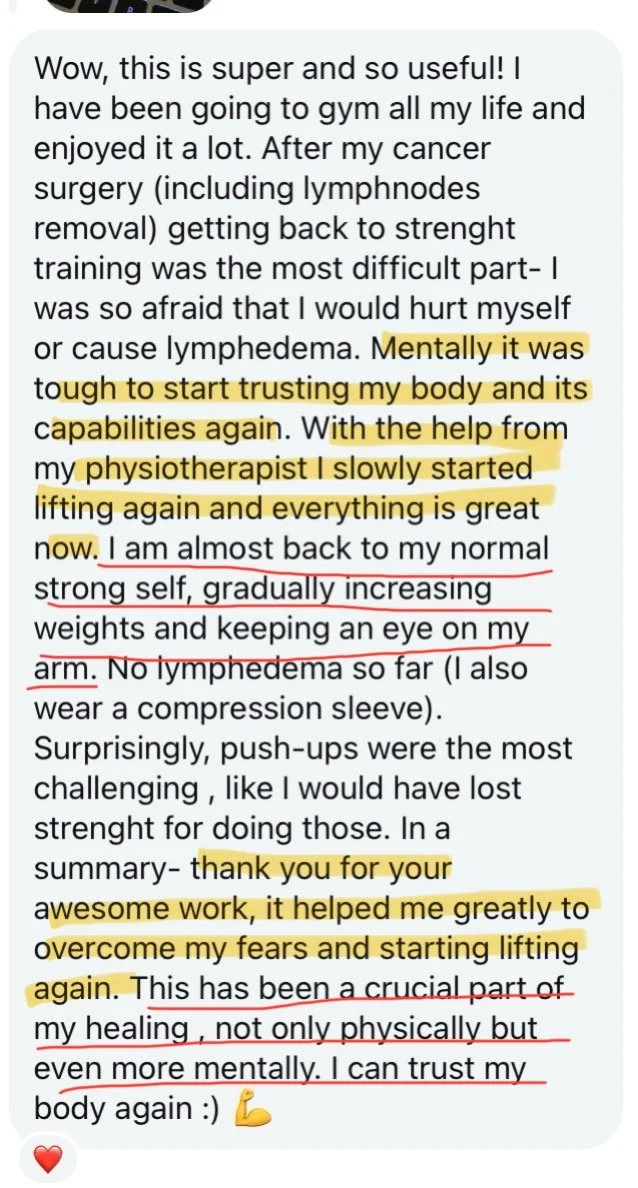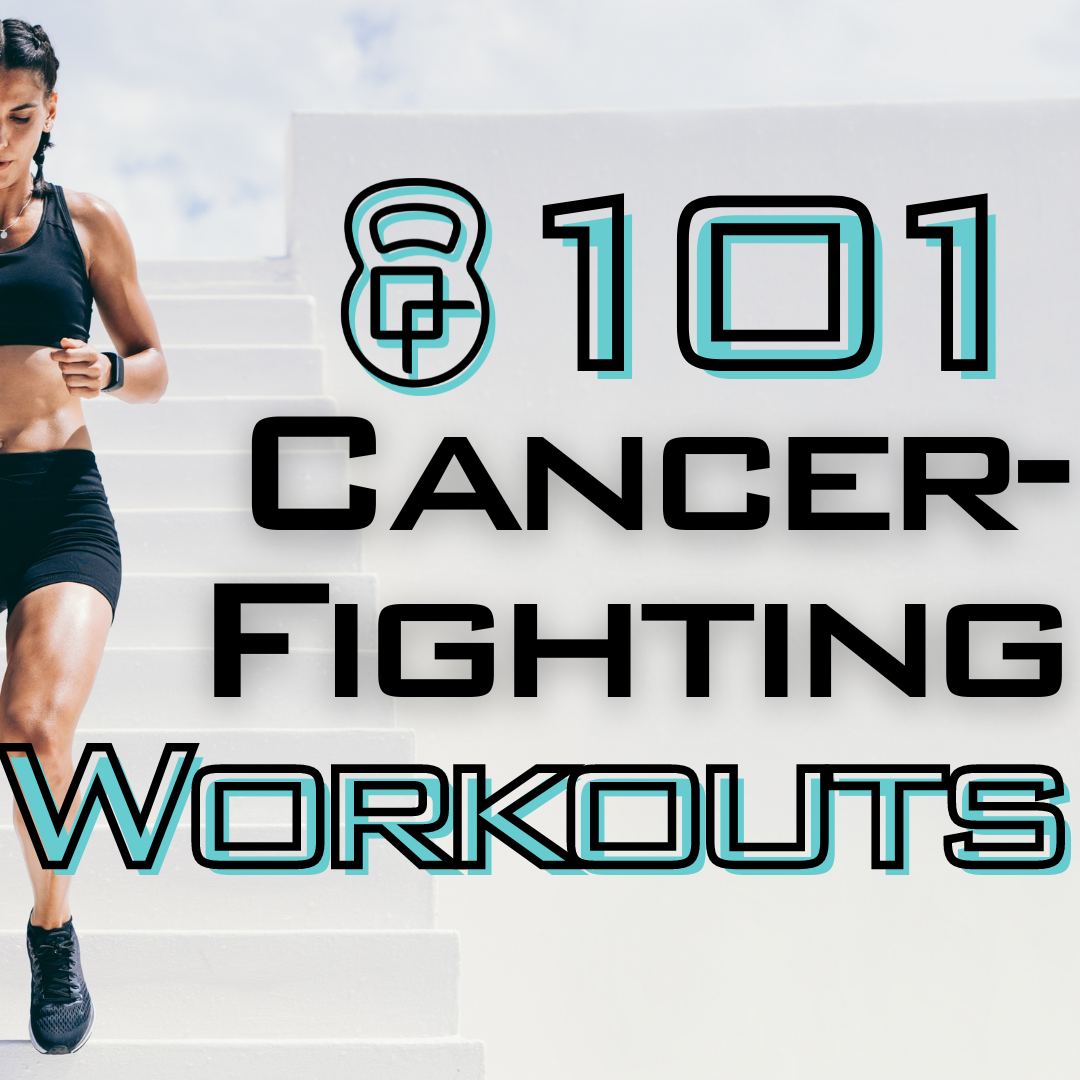Weight Lifting after Cancer 101
Long-term survivors who feel weak
Survivors dealing with fatigue or lymphedema
Here’s what you need to know 👇
Yes, you can lift weights after cancer—and you should.
There is no medication that prevents you from exercising.
Get medical restrictions on how much weight you can lift if you have a PICC line, a port, or are within 6-8 weeks of surgery.
Remember that weight lifting is the only “pill” that helps improve fatigue, bone health, mood, and survivorship without the negative side effects.
Start small. Think: form > weight.
Let’s begin!
Weight lifting Principles to keep you safe after cancer
Do not put weight on areas with cancer metastasis.
This includes high-impact exercises, like running or jumping.
Always check with your oncologist for any restrictions you need to know about.
Do not exercise if you have a lymphedema flare-up.
If you have irritation or an infection, avoid exercise.
If you have an uncontrolled heart rate, avoid cardio.
Focus on lifting weights, and include cardio once you are cleared.
Use accommodations and modify your movements. Understanding your limitations and working with the range of motion your body allows helps you stay healthy.
99% of my online coaching is showing my online coaching clients how to exercise in their “new” body.
Tailor your plan according to your needs.
Provide your body with the accommodations it needs, such as Nordic pools, TRX, or an elevated platform during exercise to help you keep your balance while allowing you to push yourself.
Start Small. Progress Slowly.
Healing isn’t a race. Focus on consistency, not intensity.
You will see benefits as you continue with exercise.
Meet with a Cancer Exercise Specialist (CES).
Work with someone who knows and understands your condition. Look for someone trained in oncology rehabilitation (like a Clinical Exercise Physiologist or Cancer Exercise Specialist).
What If I Have Lymphedema?
Research in breast cancer has shown that supervised, progressive weight training does NOT cause or aggravate lymphedema.
Studies on exercise show that exercise may reduce flare-ups by improving lymphatic circulation.
The muscles act as a pump to move fluid around your body, so when you avoid movement, your muscles can’t act as a pump.
Here is an example of how exercise can help.
Note: Lymphedema risk increase if you’ve had lymph nodes removed, radiation over the lymph nodes, obesity, and/or lack of movement.
Currently, there are no limitations on how much weight you can lift after lymphedema, but if possible:
Work with a cancer exercise specialist.
Start with low weights and gradually add more weight over time on areas you’ve had lymph nodes removed.
There is no limit to how much your legs can lift. They will progress faster than your arms if you’ve had lymph nodes removed and vice versa.
Track swelling after workouts and report changes to your care team.
Do not exercise if you have a fever.
Reduce weight or stop specific exercises if you feel any swelling or irritation
For more information on weight lifting safety after cancer, watch this video.
Always follow lymphedema management best practices, such as:
Moisturize and practice good skin hygiene after lifting to avoid infection.
Monitor for signs of lymphedema.
Pitting oedema (as per video)
Fluctuating/intermittent swelling of the arm and/or hand
Heaviness/tightness/fatigue of the arm
Pain in the arm
Pins and needles in the arm
Loss of definition around tendons/joints
Indentations left after jewelry or clothing are removed. Wear your compression garment during exercise to help push fluid out and prevent fluid from coming back into the area.
Seek immediate referral to a lymphedema therapist if you have any signs and symptoms of lymphedema flare-ups.
Listening to your body: Good vs bad pain to avoid after cancer
After cancer, your body will quickly tell you what it can and can’t do—either through a sharp pain or a dull tug.
Therefore, it’s important to know:
Your body’s range of motion (what motion can you do without aches or pains).
How much weight it can carry (this is why starting small and increasing weight over time is important).
Proper form and adjustments to each exercise.
Unfortunately, there is no textbook on how to exercise after cancer.
But after working with 1,000s of cancer survivors, I can tell you the best way to exercise is by:
Understanding that there is no “best” or safest form of exercise.
The safest “form” is the one that your body allows. so learning to adjust is important.
This is why working with a cancer exercise specialist who can assess how to adjust the exercise to you is so important.
Here’s an example of how you can adjust your exercise to best fit your body
But there are things you should avoid:
Irritation and aggravation of your joints — knees, hips, back, shoulders, wrists—during or after exercise.
Loud popping or snapping.
Forcing your body into sharp pain and ranges of motion
Severe soreness the next day after working out. This isn’t “bad” but it’s not necessary.
Sharp pain/twinge/tweak in your muscles.
Tip: The best way to reduce pain, tweaks, and discomfort during exercise is to take 10-15 minutes to warm up. The older you are and/or the longer you’ve gone without exercise, the longer your warm-up.
However, there is also a good kind of pain, such as:
Light to mild soreness the next day after lifting weights
Light popping that brings relief, like cracking your knuckles, for example. This is extremely normal if your body hasn’t moved in the day.
Muscle “burning” or heaviness sensation.
Tip: The best way to know whether you are exercising correctly is to use the RPE scale.
How to use the RPE Scale
If you find yourself doing an RPE of 8-10, and you are super sore the next day, lower the intensity by reducing the weight, reps, or number of sets, and work within an RPE range of 5-7.
But if you don’t feel any soreness the next day at all, you may need to increase your intensity by adding more weight, reps, or sets.
However, choose only one (the weight, the reps, OR the sets) to increase.
DO NOT increase weight, reps, AND sets.
Your body processes your “intensity” based on volume.
Volume = weight x sets x reps
So, if you did 2 sets of 10 reps of 10 lbs, you did:
2 sets x 10 reps x 10 lbs = 200 lbs
But… if you did:
3 sets x 12 reps x 12 lbs = 432 lbs
You doubled the amount of weight you did in just one exercise, which can be a lot for your muscle to handle if you are not used to exercising.
Tip: to increase or decrease the intensity, only change the weight, reps, or sets, but not all three.
weight lifting goals after cancer
Optimal health comes from:
> 150 mins of moderate intensity cardio a week
At least 2 days a week of strength training
> 6,000 steps a day
Maintaining a healthy body weight
However, there is a difference between what is optimal and what your body can do to get started.
So, choose a goal that is attainable for you and stick to it for a whole year.
You need a clear direction on where you want to go to see the benefits. Do you want mobility, strength, endurance, less pain, or muscle?
If you are not sure what you need most, pick one.
Or, you can get a health evaluation from a cancer exercise specialist and learn what your body needs most to see the most impact in your first year of fitness.
What you choose determines what you need to do.
If you want more endurance this year, click here to learn more
If you want more muscle, click here to get my free muscle-building blueprint
If you want more strength, click here
If you want to reduce pain, click here
After you have determined your goal, see how many days your body and schedule allow you to exercise.
Even if it’s not optimal, just choose the number of days that your schedule and body allow.
how to properly progress
Use the first 1-2 sets of a workout as a warm-up set. This will help your body lift more and feel stronger during your workout, so that you can see benefits faster.
Increase the weight 1-2 lbs per week on areas where you’ve had surgery and 2-5 lbs per week on areas without lymph node removal.
Track your workouts. For every 1 week off from a workout, go back to the weight you used 2 weeks ago.
If you can’t do the exercise with proper form, then do not go up in weight.
Give yourself 2 weeks of lifting the same heavy weight before increasing weight.
Progressing in fitness is not always lifting more weight. It could be doing the exercise with better form, less rest, more range of motion, or more reps/sets.
free workout plan
If you are looking for a structured, easy-to-follow workout that helps reduce fatigue and improve your muscle, strength, and endurance, click the image above.
The workout plan comes with 101 workouts, so you can do 2 workouts a week.
And most workouts can be done at home, in a park, or at the gym because I wanted to make sure exercise is always accessible to you.
Some workouts are harder than others, but you will also get links to the exercise library to learn how to exercise safely.
When Will I See Results?
You can expect to feel better within 3 weeks, and you will feel stronger, less fatigued, and more mobile within 4 to 8 weeks of consistent training.
However, this is assuming you are following the right routine.
Many cancer survivors feel more tired, drained, or in pain after exercise because they join exercise classes that aren’t individualized to their needs.
So, you can bypass the extra pain and effort by working directly with someone to help you exercise and build confidence in your new body.
It takes time to build muscle, strength, and feel better, but if you are following the wrong program, it can take longer.
There are three types of people:
Those who don’t know how to get started and either fumble on their own or never begin
Those who get the help they need to get the best results with the same or less amount of effort.
JC's Story: From Weakness to Warrior
“After working with hundreds of survivors, I’ve seen how transformative lifting can be. One client—a breast cancer survivor in her 60s—couldn’t lift a grocery bag when we started. Today, she’s deadlifting 65 lbs with perfect form. If she can do it, so can you.”
Click below to schedule a 1-1 coaching discovery call, and see if online coaching is the best fit for you.
Hey!
Welcome, I'm your trainer JC 🤓
Thanks for stopping by the blog!
You'll find lots of resources on health, fat loss, nutrition, exercise, and cancer prevention.
P.s. don’t forget to grab your free gift below.
Enjoy













